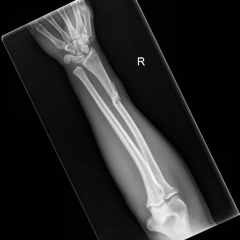

The second classification system is based on Rettig ME and Raskin KB who categorized Galeazzi fractures based on fracture stability. The first classifications were based on the position of the distal radius: Two classification systems have been proposed when categorizing Galeazzi fractures. Distally the radius connects with the lunate and scaphoid bones of the wrist. The proximal radial head articulates with the capitellum of the humerus (radiocapitellar joint), rotating within the annular ligament during pronation and supination. Distally the ulnar head serves as an insertion point for the TFCC, supplementing the DRUJ. Proximally the ulna consists of the olecranon and coronoid. The radiocapitellar joint largely stabilizes the proximal forearm while the TFCC predominantly supports the distal forearm. The interosseous membrane is responsible for dispersing axial load force to the forearm, 60% to the radiocapitellar joint and 40% to the ulnohumeral joint. The radius and ulna are stabilized by three groups of ligamentous structures: distally the triangular fibrocartilage complex (TFCC), the interosseous membrane, and proximally the annular ligament. The aim of arthrogryposis treatment is to achieve independent ambulation and independent upper limb function for the activity of daily living.The osseous forearm is composed of the radius and ulna bones. Classical arthrogryposis (amyoplasia), distal arthrogryposis and multiple pterygia syndromes are the different clinical features of arthrogryposis. Arthrogryposis is a term used to describe multiple joint contractures at birth associated with varying degree of muscle weakness. It is a type of autosomal dominant rhizomelic dwarfism which leads to short stature causing significant difficulty in activities of daily living. Achondroplasia is the most common cause of short-limbed dwarfism. Medical management, orthopedic management, physiotherapy management and rehabilitation specialties management are the management of OI. OI cannot be cured at present, so the goal is to “manage” the disease rather than to heal it. Looser’s classification and Sillence Classification are two classifications of OI. OI commonly known is a heterogeneous group of heritable disorders of connective tissues, characterized by bone fragility, osteopenia, and recurrent fractures with little or no apparent trauma. This chapter focuses on the osteogenesis imperfect (OI), achondroplasia, arthrogryposis multiplex congenita. Rainbow Superspeciality Hospital and Children’s Orthopedic Centre Smt NHL Municipal Medical College, Ahmedabad, Gujarat, India PD Hinduja Hospital and Research Center, Mumbai, Maharashtra, India Institute of Pediatric Orthopedic Disorders, Mumbai, Maharashtra, India,Ĭentre for Ilizarov Techniques, Chaudhary Trust Hospital, Akola, Maharashtra, India T2T Hormone Clinics PD Hinduja and Jaslok Hospital, Mumbai, Maharashtra, India T2T Hormone Clinics India SRCC Children’s Hospital Apollo and PD Hinduja and Jaslok Hospitals, Mumbai, Maharashtra, India, Sanjay Gandhi Postgraduate Institute of Medical Sciences, Lucknow, Uttar Pradesh, India, MedGenome Labs, Bengaluru, Karnataka, India Jupiter Hospital, Thane, and Lavkush Hospital for Children, Mumbai, Maharashtra, India Rainbow Superspecialty Hospital and Children’s Orthopedic Centre Smt NHL Municipal Medical College, Ahmedabad, Gujarat, India, Rainbow Superspecialty Hospital and Children’s Orthopedic Centre Smt NHL Municipal Medical College, Ahmedabad, Gujarat, India NHL Municipal Medical College Rainbow Superspeciality Hospital, Ahmedabad, Gujarat, India,

NHL Municipal Medical College, Ahmedabad,


 0 kommentar(er)
0 kommentar(er)
